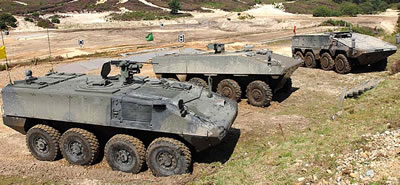Armored vehicles at DSEi 07: With a potential value of £16 billion and a potential through-life cost of £50 billion, Future Rapid Effects Systems (FRES) is the largest armored fighting vehicle program in Europe, with up to 3,000 vehicles expected to be procured. The MoD is targeting an initial operating capability in 2012. At present, the competition for the procurement of about 2,000 8×8 FRES Utility Vehicles (UV) is underway toward fielding in 2012. This family of wheeled vehicles will include variants such as a scout vehicle, to replace the current Scimitar, a direct fire platform and maneuver support vehicles (engineer and bridgelayer vehicles). In a follow-on procurement MoD is expected to select a land combat vehicle, troop carrier and mobile gun and mortar carrier systems, based on a different tracked or wheeled platforms.

The three finalists for FRES UV – French Nexter VBCI, German-Dutch BOXER built by Artec and the Swiss made General Dynamics’ / MOWAG Piranha Evolution based on the Piranha V design, participated in intensive trials held this summer. A decision based on the outcome of these tests is expected in November 07.
Artec positions its Boxer as highly attractive for co-production with British manufacturers (Britain was part of the vehicle’s original design). With its modular approach, Boxer enables local production of the rear mission module while utilizing economy of scale in the production of the main chassis.
With vehicle configuration ranging in the 30-36 ton range, Boxer will be air transportable in an A-400M aircraft. Originally, Britain pulled out of the program as the vehicle became too heavy for its requirements. However, since the heavier (more protected) FRES UV is no longer required to be air-transportable in a Lockheed C-130 Hercules, Boxer re-emerged as a candidate for the program.
Piranha also had to add weight to meet the MoD required specs. In the design of Piranha V, MOWAG increased the vehicle’s gross weight to 28 tons, with a design target weight of 30 tons, five tons over the current IV versions. It will use four steerable axles, offering improved maneuverability in urban terrain. While Piranha V seems to be the least mature vehicle of the three optional candidates, General Dynamics UK promotes it as the most attractive for Britain, since the company plans to leverage FRES to establish local production lines in the UK, delivering Piranha V vehicles to the British Army as well as for export. GD UK forecasts a world market for at least 2,000 vehicles over 10 years, on top some 3,000 destined for the FRES program. GD expects the first vehicle to roll out of the Swiss current assembly line in 2009.
One of the key requirements for FRES is the integrated protection suite, incorporating an Active Protection System (APS). At DSEi 07 General Dynamics/MOWAG demonstrated a Pirnha III vehicle fitted with Saab Avitronics LEDS active protection system, which could be included GD’s protection suite for FRES. However, active protection is being evaluated separately as part of the overall FRES program, and is not associated with a specific platform. Another program launched recently is the System of Systems Integration (SOSI), for which Thales UK and Boeing UK were selected.




















